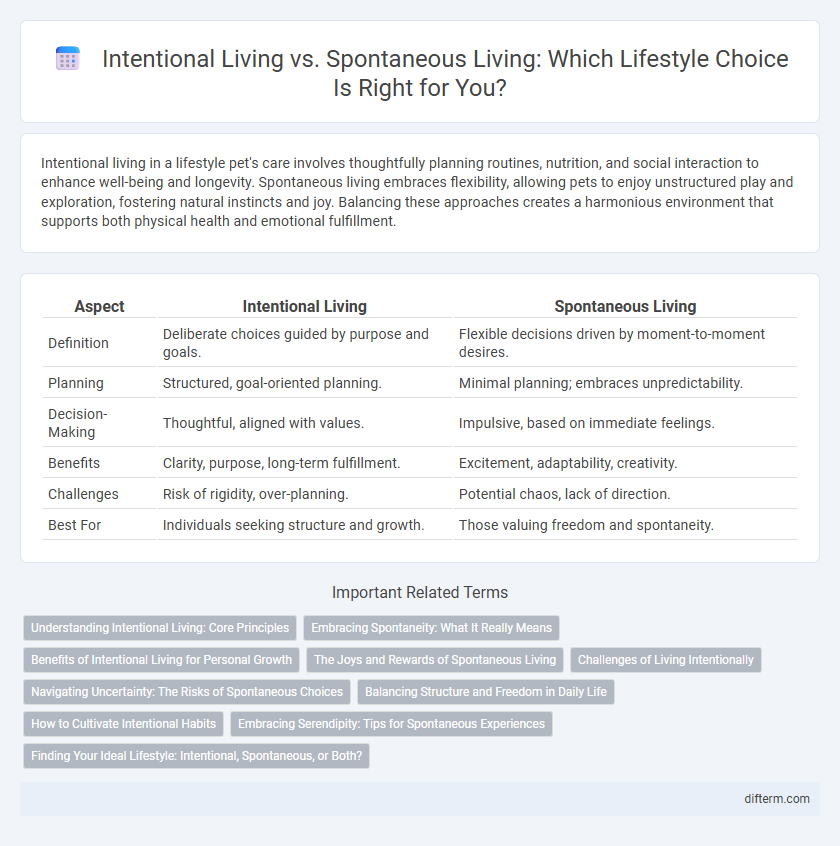Intentional living in a lifestyle pet's care involves thoughtfully planning routines, nutrition, and social interaction to enhance well-being and longevity. Spontaneous living embraces flexibility, allowing pets to enjoy unstructured play and exploration, fostering natural instincts and joy. Balancing these approaches creates a harmonious environment that supports both physical health and emotional fulfillment.
Table of Comparison
| Aspect | Intentional Living | Spontaneous Living |
|---|---|---|
| Definition | Deliberate choices guided by purpose and goals. | Flexible decisions driven by moment-to-moment desires. |
| Planning | Structured, goal-oriented planning. | Minimal planning; embraces unpredictability. |
| Decision-Making | Thoughtful, aligned with values. | Impulsive, based on immediate feelings. |
| Benefits | Clarity, purpose, long-term fulfillment. | Excitement, adaptability, creativity. |
| Challenges | Risk of rigidity, over-planning. | Potential chaos, lack of direction. |
| Best For | Individuals seeking structure and growth. | Those valuing freedom and spontaneity. |
Understanding Intentional Living: Core Principles
Intentional living centers on purposeful decision-making guided by clear values and goals, promoting mindfulness and alignment with one's true priorities. Core principles include setting deliberate priorities, cultivating self-awareness, and practicing consistent reflection to ensure actions resonate with long-term aspirations. This lifestyle approach enhances personal fulfillment by reducing distractions and fostering focused, meaningful experiences.
Embracing Spontaneity: What It Really Means
Embracing spontaneity means fully engaging with the present moment, allowing for unexpected experiences that foster creativity and personal growth. It involves letting go of rigid plans and embracing uncertainty to cultivate a more flexible and joyful lifestyle. This approach enhances emotional resilience and strengthens relationships by encouraging openness and adaptability.
Benefits of Intentional Living for Personal Growth
Intentional living fosters personal growth by promoting self-awareness and deliberate decision-making, which leads to improved mental clarity and goal achievement. This approach encourages consistent habits and prioritization of values, resulting in enhanced emotional resilience and deeper fulfillment. Individuals practicing intentional living often experience greater alignment between their actions and long-term aspirations, cultivating a purposeful and balanced lifestyle.
The Joys and Rewards of Spontaneous Living
Spontaneous living offers a unique joy through unplanned adventures that ignite creativity and foster genuine connections. Embracing unpredictability encourages flexibility and resilience, leading to rewarding experiences that enrich daily life. This lifestyle promotes mindfulness, allowing individuals to savor moments of surprise and delight in the present.
Challenges of Living Intentionally
Living intentionally requires consistent self-discipline and long-term commitment to goals, often demanding significant sacrifices in daily habits and social engagements. The challenge lies in maintaining focus amid distractions and resisting the allure of instant gratification typical of spontaneous living. This lifestyle demands continuous reflection and adjustment to align actions with core values, which can create emotional and mental strain.
Navigating Uncertainty: The Risks of Spontaneous Choices
Navigating uncertainty in lifestyle decisions highlights the risks of spontaneous living, where impulsive choices can lead to unpredictable outcomes and increased stress. Intentional living encourages deliberate planning and reflection, providing stability and a clearer path toward personal goals. Embracing intentionality helps mitigate the volatility inherent in spontaneous actions, fostering resilience amid life's uncertainties.
Balancing Structure and Freedom in Daily Life
Intentional living emphasizes setting clear goals and creating routines that foster productivity and well-being, while spontaneous living values flexibility and openness to unexpected experiences. Balancing structure and freedom in daily life involves integrating planned activities with moments of unstructured time, allowing for both stability and creativity. This equilibrium enhances mental health, reduces stress, and cultivates a fulfilling lifestyle adaptable to changing circumstances.
How to Cultivate Intentional Habits
Cultivating intentional habits requires setting clear goals aligned with personal values to create consistent routines that foster growth and well-being. Prioritizing mindfulness and deliberate decision-making enhances focus on meaningful activities, reducing distractions and impulsive behaviors. Tracking progress through journaling or habit-tracking apps reinforces commitment and helps identify patterns for continual improvement in intentional living.
Embracing Serendipity: Tips for Spontaneous Experiences
Spontaneous living invites embracing serendipity by encouraging openness to unplanned moments that enrich daily life with surprise and joy. Prioritizing flexibility in scheduling allows unexpected experiences, like impromptu travel or social gatherings, to unfold naturally and create memorable stories. Cultivating mindfulness enhances awareness of opportunities for spontaneity, fostering a lifestyle where adventure and personal growth coexist seamlessly.
Finding Your Ideal Lifestyle: Intentional, Spontaneous, or Both?
Balancing intentional living with spontaneous experiences allows individuals to craft a lifestyle tailored to their values and desires, enhancing overall well-being. Prioritizing intentional habits fosters goal-oriented growth and mindfulness, while embracing spontaneity encourages creativity and adaptability in daily life. Combining these approaches supports a dynamic, fulfilling lifestyle that adapts to change while maintaining personal purpose.
Intentional living vs Spontaneous living Infographic

 difterm.com
difterm.com